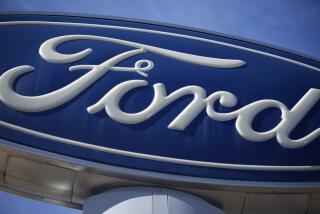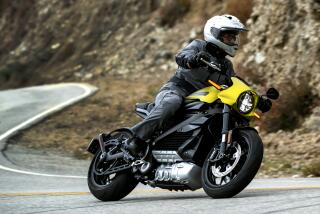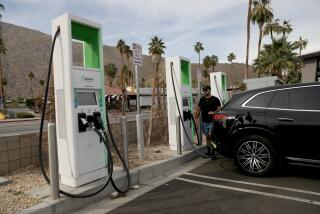The electric Mustang is just the start of Ford’s drive to hit 50 mpg in 6 years
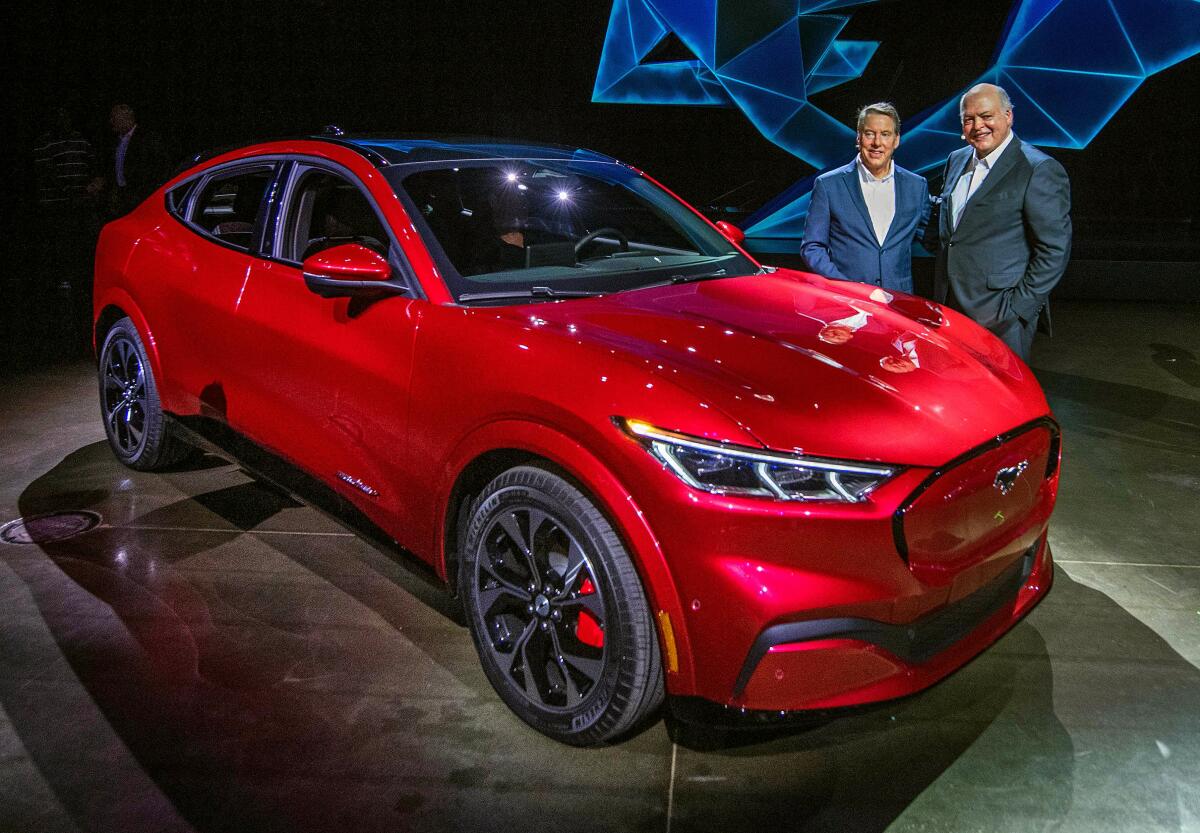
The red line — the 7,000-rpm mark on a race car’s tachometer — is the central motif in the new hit movie “Ford v Ferrari.” You can’t win a tough race, the movie makes clear, if you’re unwilling to go to the limit and risk blowing everything up.
The new Mustang Mach-E, Ford’s freshly unveiled all-electric compact sport utility vehicle now on view at the Los Angeles Auto Show, isn’t quite a bet-the-company move. But it does mess with the iconic Mustang name and marks a risky move by Ford into all-electric drivetrains, including a battery version of the F-150 pickup truck.
It also helps explain why Ford joined with three other automakers to side with California against the Trump administration on a key question: Who gets to set motor vehicle emissions regulations?
That’s a key issue for anyone planning to buy a car in California over the next several years. But the emissions fight also manifests a fundamental transformation in the automobile industry. Automakers around the world will struggle to navigate a world transforming around them with driverless vehicles, electric drivetrains and environmental mandates. Their limits will be tested like never before.
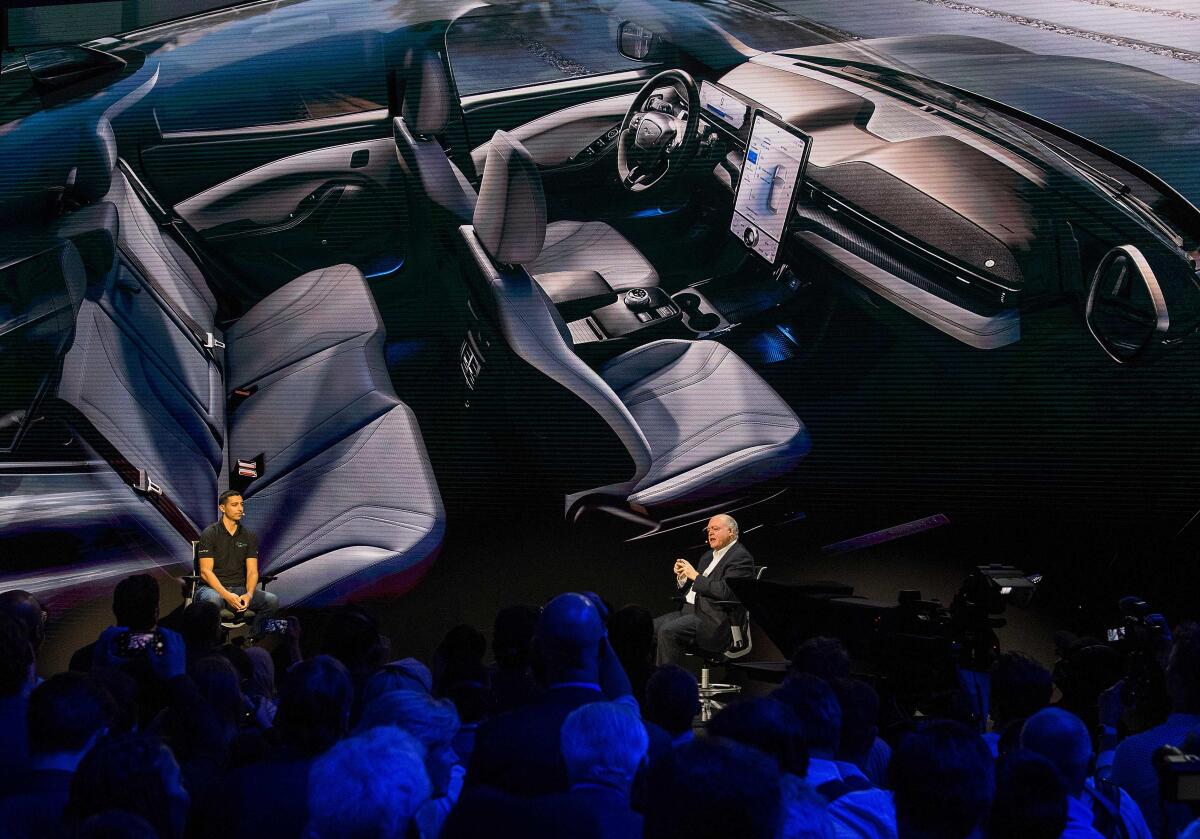
“This is a seminal point in auto industry history,” says Ford CEO Jim Hackett. And for his company, whose stock price, now around $9 a share, has been drifting downward for two decades. In September, Moody’s dropped Ford’s bond rating to junk.
Ford, Volkswagen, Honda and BMW separately struck deals in July with California air regulators to follow California’s stricter emissions regulations. The Trump administration has proposed a dramatic cutback in 2022-25 requirements set during the Obama administration. Subsequently, General Motors, Toyota, Fiat Chrysler and others sided with Trump.
Ford is counting on electrified vehicles to back up its commitment to California’s ambitious vehicle emissions goals. Ford would have to bring its fleetwide average fuel economy goals to about 50 miles per gallon by 2026, even as it exits the business of selling high-MPG small cars. The company said it can do that with a mix of hybrids and full electric vehicles, bolstered by a pure-electric version of the hulking F-150 pickup, the top-selling vehicle in America, expected to go on sale in two to three years.
Ford plans to boost sales of full-electric vehicles to a third of overall sales by 2030, up from zero today. Volkswagen, making a major bet on electric vehicles in the wake of its diesel-emissions cheating scandal, says about 15% of sales will be all electric by 2025.
Automakers would prefer to avoid a fight over emissions and abhor the prospect of dueling guidelines. Bob Holycross, Ford’s director of sustainability and environment, said the industry craves regulatory certainty, given the capital commitments and long lead times needed to plan for new products.
“Ideally, we’d have everybody together,” Holycross said.
Volkswagen of America’s Mark Gillies, senior manager for product communications, echoes the concern: “We don’t know what the regulatory environment is going to be because, in this country at least, it depends on who’s in power. It’s difficult when you have seven-year product life cycles to throw out [the regulations] because someone in the White House decided to change it.”
Unified national rules were set after General Motors and Chrysler declared bankruptcy in 2009. The industry agreed to harmonize federal and California regulations on emissions and mileage requirements through 2025.
Earlier this year, the Trump administration said it would deep-six that deal, setting up a battle with California. The Trump administration proposed freezing miles-per-gallon targets after 2020 at 37 mpg. Then, in October, it backed away from that proposal and changed to require small yearly increases in fuel efficiency — still much less strict than the Obama-California standard.
In reaching its agreement with automakers, California’s Air Resources Board agreed to relax its standards slightly, giving them another year, until 2026, to hit the 50-mpg minimum. The Justice Department opened an investigation into whether that agreement violated antitrust law. In November, California and 22 other states sued the Trump administration to challenge its right to revoke the rules.
California has been allowed to issue its own emissions regulations under exceptions granted in federal law since the 1970s. Other states are allowed to adopt those standards; 14 other states and the District of Columbia have done so. The Trump administration is arguing in court that the states can’t set mileage requirements based on greenhouse gas emissions.
Ford’s Detroit competitors were not part of the California deal. The standoff has created the impression that automakers have taken sides in a bipolar battle that pits green-leaning carmakers against fossil fuel die-hards. General Motors is making electrified vehicles, as is Fiat Chrysler Automobiles, parent company of the Dodge, Ram, Chrysler and Jeep brands.
But neither GM nor Chrysler has laid out its plans as clearly as Ford, and neither has set percentage goals for electrification. At a time when corporate chiefs seem wary of calling out discrepancies with the Trump White House, it was telling that Ford Chairman Bill Ford posed alongside Mary Nichols, chairwoman of the California Air Resources Board, at the Mach-E launch last Sunday.
The Trump vs. California contest obscures some of the advances automakers have made in fuel efficiency, executives argue.
Mazda, which has led the market in overall-fleet fuel efficiency for the last five years, has electric cars in the works. But right now it employs a unique set of gasoline engine technologies called Skyactiv that combine the most efficient elements of gasoline and diesel engines to reduce fuel consumption and boost performance. The company is adding small-battery “mild hybrid” technologies to further reduce fuel use.
Jeffrey Guyton, president of Mazda North American Operations, said the politics of emissions and electrification don’t account for the fact that while electric vehicles emit no greenhouse gases, 64% of the electric power they’d draw from across the U.S. is produced by fossil fuels, mainly coal and natural gas, according to U.S. Energy Information Administration statistics.
“Our technology approach is informed by the whole ‘well-to-wheel’ cycle,” Guyton said. “We believe we are able to create combustion-powered vehicles that perform better than electric vehicles” when original power sources are included.
Mazda was fine with the Obama regulations, he said. But the deal with California, according to the Air Resources Board, includes extra incentives for pure-electric vehicles that Guyton says discriminates against carmakers taking a different technological approach to fuel economy and greenhouse gas reduction.
Ford’s EcoBoost engines helped boost mileage and reduce pollution even in the company’s largest pickups and SUVs. But the company has the scale and the cash flow to invest heavily in electric powertrains, too.
The Mustang Mach-E, which goes on sale sometime next year, will serve as Ford’s EV image leader. The Mach-E draws design and performance inspiration from the original Mustang sport coupe. That car’s 1964 debut helped modernize Ford’s reputation for stodgy cars with grandpa appeal, and created the sporty “pony car” category. Camaros, Firebirds, Chargers and Challengers followed.
Whether customers will go along with that plan is to be determined. Up to now, EVs account for an infinitesimal but growing share of the overall car market: less than 2% across the U.S., according to the Edison Electric Institute. (Electric-vehicle sales grew 64% in California through the first half of the year, mostly because of Tesla’s Model 3 sedan.)
The new Mustangs won’t hit the market until later next year. With an estimated range of 250 to 300 miles, top horsepower of 459 and a base price ranging from $44,000 to $60,000 before government incentives, the cars are aimed at broadening the existing EV market. Ford also says it will offer an extensive national charging network with 12,500 points across the U.S., in partnership with Electrify America, Greenlots and other charger companies.
Some EV advocates, including the Sierra Club and other environmental groups, claim car dealers aren’t enthusiastic about electric cars, in part because they’re easier to maintain and could cut into service revenue. Ford said it is working with dealers to boost EV sales, and Volkswagen said it is looking for ways to boost dealer profit margins on EVs.
Industry executives acknowledge that vehicles like the new Mustang could provide a halo effect for other EV makers. “You’re seeing companies launching cool cars and you’re seeing a classic automotive arms race, who can put the next cool thing out there,” said Scott Keogh, chief executive of Volkswagen of America. “All this is building confidence among the consumer base.”
Soon after Hackett took over in 2017, Ford dropped slow-selling, low- to no-profit small sedans from its product lineup to focus on crossovers, SUVs, pickup trucks and performance cars. And it redoubled its commitment to hybrids and electrics, with a pledge to spend $11 billion on alternative powertrains between now and 2023.
The commitment includes Ford’s crown jewel, the F-150, which not only leads the pickup segment but represents the top-selling motor vehicle of any kind in North America.
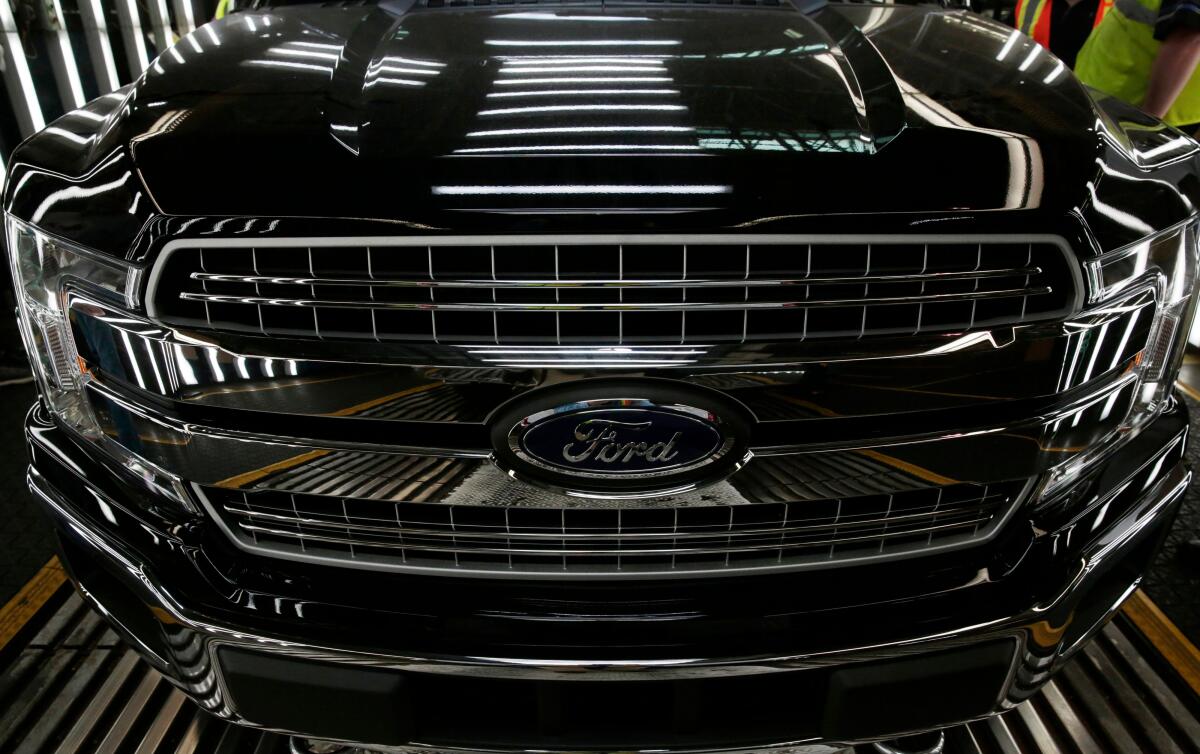
Converting just a small percentage of the pickup market to electricity would move Ford a long way toward meeting greenhouse gas regulatory requirements and the company’s own sustainability goals. Already, Ford has produced the pickup world’s most efficient engines and saved more fuel by taking weight off the F-150. Largely by replacing steel with aluminum and adding electronics for some mechanical functions, Ford cut 700 pounds from its largest pickup truck model.
A hybrid version of the F-150 is due late in 2020, with an all-electric pickup a year or two after that. Ford executives hope that by then, a successful Mustang launch will have eased the way.
“We’re leaning into the segments and the nameplates that brought us here,” said Ted Cannis, Ford’s global director for electrification. He also hopes to normalize the very idea of buying an electric vehicle, which he thinks most customers regard as glorified golf carts or ultra-expensive.
“The full electric F-150, what will it be called?” he said. “How about the F-150.”
That could be considered a swipe at Tesla, which unveiled its much-anticipated Cybertruck electric pickup on Thursday, a possible rival for an electric F-150. Chevrolet, meanwhile, said it’s working on producing an electric Silverado by the end of 2021, and start-up Rivian plans to issue two high-end electric vehicles in 2021 — a pickup and an SUV, both of which were the hit of last year’s L.A. Auto Show. (Ford has invested $500 million in Rivian.)
Hackett’s not shy about taking on Tesla. “We sell a million F-150s in a year,” he told The Times. “Tesla hasn’t sold a million cars total in their life.”
Analysts are intrigued, but not totally sold on Ford’s plan.
“The [Mustang] Mach-E will undoubtedly help drive [EV] awareness among average Americans,” said Jessica Caldwell, market analyst at Edmunds. But, she adds, “any hybrid or EV versions of the F-150 will succeed or fail on their own merits. The F-150 is a juggernaut brand, and its buyers have certain expectations as to what that truck has to do. If Ford doesn’t meet them, it won’t matter what the Mach-E did or did not do to drive awareness or adoption of EVs as a segment.”
Ford seems to understand how sensitive those car-buyer expectations are. At the L.A. Auto Show, the Mustang Mach-E and the higher-powered Mach E GT will be displayed alongside a Mustang Shelby 500, which burns gasoline to turn out 760 horsepower. The company wants to push the Mach E and electrification “without degrading the gasoline version,” Hackett said.
Electric propulsion will be “feathered” into the Ford lineup, Hackett said. “The company is on trial here.”
More to Read
Inside the business of entertainment
The Wide Shot brings you news, analysis and insights on everything from streaming wars to production — and what it all means for the future.
You may occasionally receive promotional content from the Los Angeles Times.
